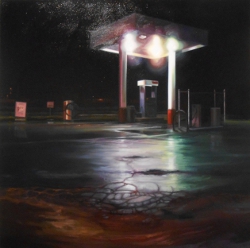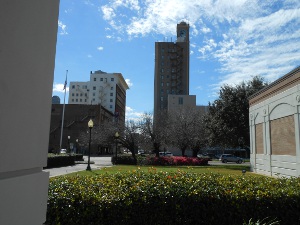 Sarah Williams scene
museum we have ever visited, but its collection is first class. We were the only visitors this morning, so the Information-Desk-Security-Guard was happy to talk to us about the artists and the museum itself.
Sarah Williams scene
museum we have ever visited, but its collection is first class. We were the only visitors this morning, so the Information-Desk-Security-Guard was happy to talk to us about the artists and the museum itself.
The Art Museum of Southeast Texas, located downtown in the oil city of Beaumont, may be the smallest art  Sarah Williams scene
museum we have ever visited, but its collection is first class. We were the only visitors this morning, so the Information-Desk-Security-Guard was happy to talk to us about the artists and the museum itself.
Sarah Williams scene
museum we have ever visited, but its collection is first class. We were the only visitors this morning, so the Information-Desk-Security-Guard was happy to talk to us about the artists and the museum itself.
Sarah Williams, a young art teacher at the Missouri State University, has created an evocative collection of paintings she calls Remote America. Working in oils she paints scenes near her rural home, always at night, always with a total absence of people. She includes gas stations, a car wash, street surfaces after rain, all moving and beautiful.
 Felix Harris wagon
Felix Harris wagon
A gifted and well-known Texas photographer, David H. Gibson, also makes scenes without people. His black and white photos of land forms are surprising and elegant. Among them are a flooded field of locust stems which bend until they look like runic calligraphy, views of cypress trees along the edge of a bayou, and an extended series of photos of sky and lake taken in New Mexico, which he has made into an accordion book.
In contrast with these artists is folk artist Felix "Fox" Harris, a Beaumont man who worked 50 years for  Beaumont from the museum
the railroad, then retired and soon began his life's big project in response to what he saw as a message from God. Harris built an installation of found objects which eventually filled his front yard. Eventually it attracted attention not only from neighbors (who called him "the Voodoo Man") but also from tourists as the word spread. After his death the City determined to tear down the structure, but his nephew donated it, along with Harris' other works, to the museum which has made it a major part of their permanent collection. To build it, he used only two tools: a ball-peen hammer and a case knife (both of which are displayed in their own glass case in the gallery). We count ourselves connoiseurs of folk art, which we have stumbled across on back roads and in small towns across the country, and Harris' work is typically compelling. We are glad to see these "personal visions" find a home in museums.
Beaumont from the museum
the railroad, then retired and soon began his life's big project in response to what he saw as a message from God. Harris built an installation of found objects which eventually filled his front yard. Eventually it attracted attention not only from neighbors (who called him "the Voodoo Man") but also from tourists as the word spread. After his death the City determined to tear down the structure, but his nephew donated it, along with Harris' other works, to the museum which has made it a major part of their permanent collection. To build it, he used only two tools: a ball-peen hammer and a case knife (both of which are displayed in their own glass case in the gallery). We count ourselves connoiseurs of folk art, which we have stumbled across on back roads and in small towns across the country, and Harris' work is typically compelling. We are glad to see these "personal visions" find a home in museums.